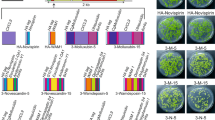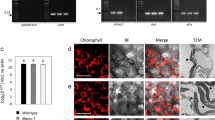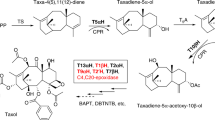Abstract
5 – Enolpyruvylshikimate – 3 – phosphate (EPSP) synthase is a chloroplast–localized enzyme of the shikimate pathway in plants. The enzyme is synthesized as a cytoplasmic precursor with an N–terminal transit peptide sequence that post–translationally directs import into chloroplasts. EPSP synthase is of significant agronomic importance because it is the primary target for glyphosate, the active ingredient in the herbicide. Roundup®. A gene from Escherichia coli encoding a mutant, glyphosate resistant form of EPSP synthase was fused behind a portion of the cDNA that encodes the transit peptide sequence of Petunia hybrida EPSP synthase. A chimeric enzyme, produced by in vitro transcription and translation of the gene fusion, was rapidly imported into chloroplasts and proteolytically processed to give a stable, glyphosate resistant enzyme.
This is a preview of subscription content, access via your institution
Access options
Subscribe to this journal
Receive 12 print issues and online access
$209.00 per year
only $17.42 per issue
Buy this article
- Purchase on Springer Link
- Instant access to full article PDF
Prices may be subject to local taxes which are calculated during checkout
Similar content being viewed by others
References
Franz, J.E. 1985. Discovery, development and chemistry of glyphosate, p. 3–17. In: The Herbicide Glyphosate. E. Grossman and D. Atkinson (eds.), Butterworths, London.
Steinrücken, H.C. and Amrhein, N. 1980. The herbicide glyphosate is a potent inhibitor of 5-enolpyruvylshikimic acid-3-phosphate synthase. Biochem. Biophys. Res. Commun. 94: 1207–1212.
Jaworski, E.G. 1972. Mode of action of N-phosphonomethylglycine: inhibition of aromatic amino acid biosynthesis. J. Agric. Food Chem. 20: 1195–1198.
Shah, D.M., Horsch, R.B., Klee, H.J., Kishore, G.M., Winter, J.A., Tumer, N.E., Hironaka, C.M., Sanders, P.R., Gasser, C.S., Aykent, S., Siegel, N.R., Rogers, S.R. and Fraley, R.T. 1986. Engineering herbicide tolerance in transgenic plants. Science 233: 478–481.
della-Cioppa, G., Bauer, S.C., Klein, B.K., Shah, D.M., Fraley, R.T. and Kishore, G.M. 1986. Translocation of the precursor of 5-enolpyruvylshikimate-3-phosphate synthase into chloroplasts of higher plants in vitro. Proc. Natl. Acad. Sci. USA 83: 6873–6877.
Comai, L., Facciotti, D., Hiatt, W.R., Thompson, G., Rose, R.E. and Stalker, D.M. 1985. Expression in plants of a mutant aroA gene from Salmonella typhimurium confers tolerance to glyphosate. Nature 317: 741–744.
Mousdale, D.M. and Coggins, J.R. 1985. Subcellular localization of the common shikimate-pathway enzymes in Pisum sativum L. Planta 163: 241–249.
Siehl, D.L., Singh, B.K. and Conn, E.E. 1986. Tissue distribution and subcellular localization of prephenate aminotransferase in leaves Sorghumn bicolor. Plant. Physiol. 81: 711–713.
Kishore, G.M., Brundage, L., Kolk, K., Padgette, S.R., Rochester, D., Huynh, K. and della-Cioppa, G. 1986. Isolation, purification and characterization of a glyphosate tolerant mutant E. coli EPSP synthase. Fed. Proc. 45: 1506.
Van den Broeck, G., Timko, M.P., Kausch, A. P., Cashmore, A.R., Van Montagu, M. and Herrera-Estrella, L. 1985. Targeting of a foreign protein to chloroplasts by fusion to the transit peptide from the small subunit of ribulose 1,5-bisphosphate carboxylase. Nature 313: 358–363.
Schreier, P.H., Seftor, E.A., Schell, J. and Bohnert, H.J. 1985. The use of nuclear-encoded sequences to direct the light-regulated synthesis and transport of a foreign protein into plant chloroplasts. EMBO J. 4: 25–32.
Wasmann, C.C., Reiss, B., Barlett, S.G. and Bohnert, H.J. 1986. The importance of the transit peptide and the transported protein for protein import into chloroplasts. Mol. Gen. Genet. 205: 446–453.
Lubben, T.H. and Keegstra, K. 1986. Efficient in vitro import of a cytosolic heat shock protein into pea chloroplasts. Proc. Natl. Acad. Sci. USA 83: 5502–5506.
Duncan, K., Lewendon, A. and Coggins, J.R. 1984. The complete amino acid sequence of Escherichia coli 5-enolpyruvylshikimate 3-phosphate synthase. FEBS Lett. 170: 59–63.
Krieg, P.A. and Melton, D.A. 1984. Functional messenger RNAs are produced by SP6 in vitro transcription of cloned cDNAs. Nucleic Acids Res. 12: 7057–7070.
Laemmli, U.K. 1970. Cleavage of structural proteins during the assembly of the head of the bacteriophage T4. Nature 227: 680–685.
Bartlett, S.G., Grossman, A.R. and Chua, N.-H. 1982. In vitro synthesis and uptake of cytoplasmically-synthesized chloroplast proteins, p. 1081–1091. In: Methods in Chloroplast Molecular Biology. M. Edelman, R. B. Hallick, and N.-H. Chua (eds.). Elsevier Biomedical Press, New York, N.Y.
Bradford, M.M. 1976. A rapid and sensitive method for the quantita-tion of microgram quantities of protein utilizing the principle of protein-dye binding. Analyt. Biochem. 72: 248–254.
Author information
Authors and Affiliations
Rights and permissions
About this article
Cite this article
della-Cioppa, G., Christopher Bauer, S., Taylor, M. et al. Targeting a Herbicide–Resistant Enzyme from Escherichia Coli to Chloroplasts of Higher Plants. Nat Biotechnol 5, 579–584 (1987). https://doi.org/10.1038/nbt0687-579
Received:
Accepted:
Issue Date:
DOI: https://doi.org/10.1038/nbt0687-579



